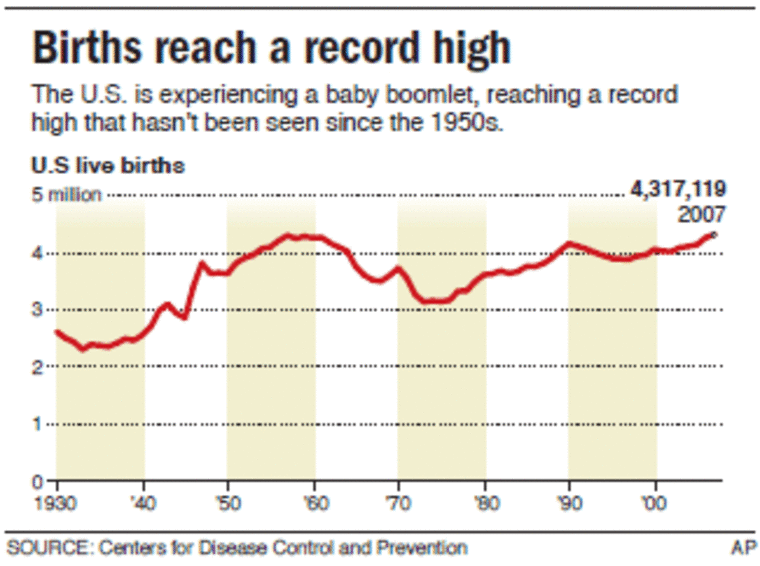A record-setting number of babies were born in the United States in 2007, and it may prove to be just another reminder of prosperity lost.
In good times, we reproduce. In bad times, we don't.
Health officials on Wednesday released a statistical snapshot of the good times: Births in this country topped 4.3 million in 2007, more than any other year in the nation's history, surpassing the peak during the post-World War II baby boom 50 years earlier.
Many of those babies were conceived in 2006, when the economy was relatively good. A nation's birth rate tends to rise in times of prosperity, according to experts.
And for that reason, this baby boomlet could end abruptly in 2008. Some think birth rates are already declining.
"I expect they'll go back down. The lowest birth rates recorded in the United States occurred during the Great Depression — and that was before modern contraception," said Dr. Carol Hogue, an Emory University professor of maternal and child health.
Behind the 2007 record, however, was some good news and some bad news. For example:
- The U.S. population is more than replacing itself, a healthy trend.
- However, the teen birth rate was up for the second year in a row.
The birth rate rose slightly for women of all ages, and births to unwed mothers reached an all-time high of about 40 percent, continuing a trend begun years ago. More than three-quarters of these women were 20 or older.

For a variety of reasons, it's become more acceptable for women to have babies without a husband, said Duke University's S. Philip Morgan, a leading fertility researcher.
Even happy couples may be living together without getting married, experts say. Some cited a growing trend among all adult women to have children regardless of their marital status.
The new numbers suggest the second year of a baby boomlet, with U.S. fertility rates higher in every racial group, the highest among Hispanic women. On average, a U.S. woman has 2.1 babies in her lifetime. That's the "magic number" required for a population to replace itself.
Countries with much lower rates — such as Japan and Italy — face future labor shortages and eroding tax bases as they fail to reproduce enough to take care of their aging elders.
Will boomlet last?
But it's not clear the boomlet will last long.
"I expect they'll go back down. The lowest birth rates recorded in the United States occurred during the Great Depression — and that was before modern contraception," said Dr. Carol Hogue, an Emory University professor of maternal and child health.
The 2007 statistical snapshot reflected a relatively good economy coupled with cultural trends that promoted childbirth, she and others noted.
Meanwhile, U.S. abortions have been dropping to their lowest levels in decades, according to other reports. Some have attributed the abortion decline to better use of contraceptives, but other experts have wondered if the rise in births might indicate a failure in proper use of contraceptives. Some earlier studies have shown declining availability of abortions.
Cultural attitudes may be a more likely explanation. Morgan noted the pregnancy of Bristol Palin, the unmarried teen daughter of former GOP vice presidential candidate Sarah Palin. The young woman had a baby boy in December, and plans for a wedding with the father, Levi Johnston, were scrapped.
"She's the poster child for what you do when you get pregnant now," Morgan said.
Teen women tend to follow what their older sisters do, so perhaps it's not surprising that teen births are going up just like births to older women, said Sarah Brown, the chief executive for the National Campaign to Prevent Teen and Unplanned Pregnancy.
Indeed, it's harder to understand why teen births had been declining for about 15 years before the recent uptick, she said. It may have been due to a concentrated societal effort to reduce teen births in the 1990s that has waned in recent years, she said.
Health officials cautioned that the rise in teen births is not the chief cause of the increase in births to unwed mothers. Unmarried births were up for women of all ages, and were an astonishing 60 percent for women in their early 20s — the group that has the largest number of babies.
The statistics are based on a review of most 2007 birth certificates by the National Center for Health Statistics, part of the Centers for Disease Control and Prevention. The numbers also showed:
- Nearly 72 percent of the births to black women were out of wedlock. Mothers were unmarried in about 51 percent of Hispanic births and 28 percent of non-Hispanic white births.
- Cesarean section deliveries continue to rise, now accounting for almost a third of all births. Health officials say that rate is much higher than is medically necessary. About 34 percent of births to black women were by C-section, more than any other racial group. But geographically, the percentages were highest in Puerto Rico, at 49 percent, and New Jersey, at 38 percent.
- The pre-term birth rate, for infants delivered at less than 37 weeks of pregnancy, declined slightly. It had been generally increasing since the early 1980s. Experts said they aren't sure why it went down.
- Among the states, Utah continued to have the highest birth rate and Vermont the lowest.
CDC officials noted that despite the record number of births, this is nothing like what occurred in the 1950s, when a much smaller population of women were having nearly four children each, on average. That baby boom quickly transformed society, affecting everything from school construction to consumer culture.
Today, U.S. women are averaging 2.1 children each. That's the highest level it's been since the early 1970s, but is a relatively small increase from the rate it had hovered at for more than 10 years and is hardly transforming.
"It's the tiniest of baby booms," said Morgan in agreement. "This is not an earthquake; it's a slight tremor."